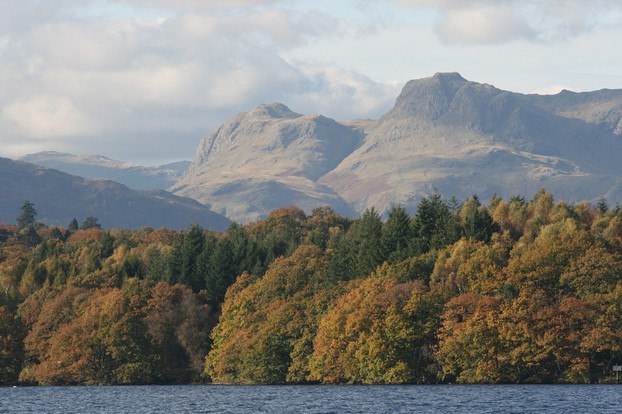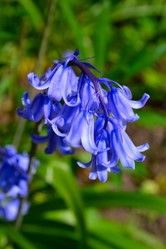Having set off from Stretford, Greater Manchester at 8.30 am.we arrived at Elterwater ninety minutes later. The name belongs to a small village at the mouth of Langdale and to a small lake of the same name. As you drive the car into the village you come through a patch of very rough, hummocky ground, which I recognise as a glacial moraine from the glacier which carved out Langdale. The rough ground is in contrast with the well-kept little village of Elterwater with its friendly, well-maintained faciities, where we were later to lunch.
The plan was to go to Elterwater before our accommodation and walk round the lake, enjoying the woods, water and quietness. We had chosen this walk because Langdale was the location of our first holiday together, but we had in the past concentrated our efforts on the more jagged, higher peaks of the western part of the dale. With the mellowing of years comes the realisation that lower levels have their charms, especially flowers; and I have been carrying an injury to my lower back for quite some time, so some care is needed.
Having snacked at a cafe [bacon sandwich for me, toasted teacake for her, with tea of course] we set off on a beautifully maintained path besides the river that flows from Elterwater down to Windermere. With the river to our right and fields of sheep yet to have their fleeces sheared, it was a typical Lake District stroll, done to the gentle trilling of the river.
Soon we reached wood-clad Elterwater, whose name in the Norse-based old Cumbrian dialect means Swan Lake. There must have been swans there for the Norse to give the lake this name, but we saw none. But the woods have their enchantment.The bright yellow of dandelions was supplemented by the yellow of their near relatives hawkweed. But the riverside and lakeside woods were filled with the small white flower heads of wood anemones, which were gloriously abundant among the trees. The daffodils which are prolific in this territory so familiar to the poet Wordsworth, were already past their prime and were fading, but in succession the woodland glades luxuriated in bluebells, the genuine English bluebell rather than the invasive Spanish bluebell and its hybrids.
The woods contained a variety of trees. Silver birch and hazel were richly present, and the white blossom of elderflower blessed the trees with the promise of berries to come. Willows hung over the lake, enjoying the wet environment. Yet the river held in its grip a small tree roots and all, as if to remind us of the winter storms that beset Northern England. The woodland looked like an old wood to me,for I could spot the multiple stems that come from stumps that have been coppiced, an ancient practice only just coming back into fashion.
Peering through the trees we espied a cluster of ducks on the lake,one of which was a female goosander, a red beaked species that I have not seen before.
We walked all the way around Elterwater, the first time that I have paid this small watery gem as much attention as it deserves.









 TheThousand Year Gardenon 11/26/2025
TheThousand Year Gardenon 11/26/2025
 Women of the Gospelson 10/11/2025
Women of the Gospelson 10/11/2025
 Religious Gardenson 08/25/2025
Religious Gardenson 08/25/2025
 Doctor of the Church: John Henry Newmanon 08/03/2025
Doctor of the Church: John Henry Newmanon 08/03/2025



Comments
Of course, the sandwich filling can augment the bacon with a variety of vegetable fillings. I do often take my bacon sandwiches toasted.
Thank you!
The Unitedstatesian-styled bacon sandwich also can be atop or in-between a roll as well as in-between a bun, a croissant or two bread slices.
Does the east-ponder bacon sandwich defer to toasted or untoasted bread and to such other ingredients as butter or mayo, cheese, lettuce, tomato?
Yes, often we eat bacon on a roll, which is a bun made of bread. Sometimes this is known in the North as a harm
Thank you for your answer about raisin-, blueberry-, bilberry-sporting tea cakes in response to my previous question.
The third paragraph to the first subheading, Elterwater, invokes a bacon sandwich.
Unitedstatesian bacon sandwiches typically involve toasted sliced bread (or rye crisp for west-ponders such as me unfond of sliced bread).
Might the east-ponder bacon sandwich require bread or buns (such as the McDonald burger buns) or something else?
Raisins are very common in tea cakes, but there could be other fruits, such as blueberries and bilberries.
Thank you for your comment July 8, 2019, in answer to my previous, same-day question.
The comment box below contains the appetizing description of teacakes as muffins with fruit.
Does any fruit do or might certain fruits be likelier in teacakes than others?
I was not aware that toasted tea cakes were known as English muffins.In England usage varies, but teacakes are muffins with fruit in them. Muffins have no fruit, but in some areas are known as baps and in the North West barms or barm cakes, though this usage is fading out.
I cannot give you any more information on Lakeland blend than I have given. Sorry!
Water shortages are likely to hit the south east of Britain, but northwest of the Tees-Exe line [an imaginary line running from the river Exe in the South West to the river Tees in north East England,] which is roughly the division between highland Britain and lowland we will get enough water, but with stormier winters. In my area allotments will be safe.
frankbeswick, Thank you for the explanation of hedge-laying; foray among bluebells (Virginia, not English or Spanish, here), daffodils, dandelions, elderflowers, hawkweed and wood anemone; and the products.
Are toasted teacakes what this side of the pond calls English muffins?
What are the Lakeland tea blends? Bing-ing, Google-ing and Yahoo-ing just gave me Farrers and Penningtons tea merchants without other than general identification of Sri Lanka by the former and "the finest Indian, Sri Lankan and African teas" by the latter. The former and latter respectively indicate that "Our own blend of the quality Ceylon teas specially blended to compliment the Lakeland 'soft' water" and "Our Lakeland tea is suited to both hard and soft water areas."
In another but somewhat related direction, I remember reading about a U.K.-based report about scaling back on water use within the next decade or two. How would that affect allotments?
You have some interesting terrain.
I know his cottage in Grasmere, but I did not know that he had a cottage in nearby Rydal.